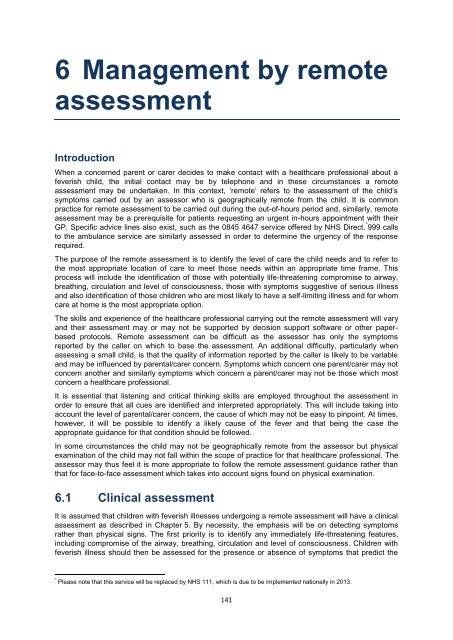A5V4d
A5V4d
A5V4d
You also want an ePaper? Increase the reach of your titles
YUMPU automatically turns print PDFs into web optimized ePapers that Google loves.
6 Management by remote<br />
assessment<br />
Introduction<br />
When a concerned parent or carer decides to make contact with a healthcare professional about a<br />
feverish child, the initial contact may be by telephone and in these circumstances a remote<br />
assessment may be undertaken. In this context, ‘remote’ refers to the assessment of the child’s<br />
symptoms carried out by an assessor who is geographically remote from the child. It is common<br />
practice for remote assessment to be carried out during the out-of-hours period and, similarly, remote<br />
assessment may be a prerequisite for patients requesting an urgent in-hours appointment with their<br />
GP. Specific advice lines also exist, such as the 0845 4647 service offered by NHS Direct. * 999 calls<br />
to the ambulance service are similarly assessed in order to determine the urgency of the response<br />
required.<br />
The purpose of the remote assessment is to identify the level of care the child needs and to refer to<br />
the most appropriate location of care to meet those needs within an appropriate time frame. This<br />
process will include the identification of those with potentially life-threatening compromise to airway,<br />
breathing, circulation and level of consciousness, those with symptoms suggestive of serious illness<br />
and also identification of those children who are most likely to have a self-limiting illness and for whom<br />
care at home is the most appropriate option.<br />
The skills and experience of the healthcare professional carrying out the remote assessment will vary<br />
and their assessment may or may not be supported by decision support software or other paperbased<br />
protocols. Remote assessment can be difficult as the assessor has only the symptoms<br />
reported by the caller on which to base the assessment. An additional difficulty, particularly when<br />
assessing a small child, is that the quality of information reported by the caller is likely to be variable<br />
and may be influenced by parental/carer concern. Symptoms which concern one parent/carer may not<br />
concern another and similarly symptoms which concern a parent/carer may not be those which most<br />
concern a healthcare professional.<br />
It is essential that listening and critical thinking skills are employed throughout the assessment in<br />
order to ensure that all cues are identified and interpreted appropriately. This will include taking into<br />
account the level of parental/carer concern, the cause of which may not be easy to pinpoint. At times,<br />
however, it will be possible to identify a likely cause of the fever and that being the case the<br />
appropriate guidance for that condition should be followed.<br />
In some circumstances the child may not be geographically remote from the assessor but physical<br />
examination of the child may not fall within the scope of practice for that healthcare professional. The<br />
assessor may thus feel it is more appropriate to follow the remote assessment guidance rather than<br />
that for face-to-face assessment which takes into account signs found on physical examination.<br />
6.1 Clinical assessment<br />
It is assumed that children with feverish illnesses undergoing a remote assessment will have a clinical<br />
assessment as described in Chapter 5. By necessity, the emphasis will be on detecting symptoms<br />
rather than physical signs. The first priority is to identify any immediately life-threatening features,<br />
including compromise of the airway, breathing, circulation and level of consciousness. Children with<br />
feverish illness should then be assessed for the presence or absence of symptoms that predict the<br />
* Please note that this service will be replaced by NHS 111, which is due to be implemented nationally in 2013.<br />
141


